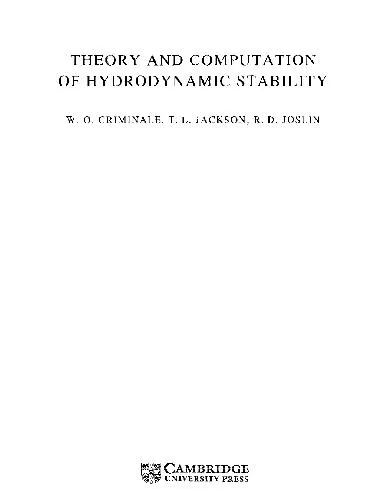Theory and Computation of Hydrodynamic Stability Criminale
4.5
Reviews from our users

You Can Ask your questions from this book's AI after Login
Each download or ask from book AI costs 2 points. To earn more free points, please visit the Points Guide Page and complete some valuable actions.Introduction to "Theory and Computation of Hydrodynamic Stability"
Hydrodynamic stability plays an integral role in understanding fluid flow phenomena across a wide range of applications in science and engineering. The book "Theory and Computation of Hydrodynamic Stability", authored by William O. Criminale, Thomas Luther Jackson, and Ronald Douglas Joslin, provides a comprehensive exploration of this complex yet fascinating topic. It seamlessly integrates foundational theory with computational methods, empowering both students and practitioners to analyze fluid stability problems with depth and precision.
With the increasing need for accurate predictions of fluid behavior in diverse fields such as aerodynamics, meteorology, and industrial processes, this book serves as an indispensable resource for readers seeking mastery in hydrodynamic stability. Its elegant balance of mathematical rigor and computational practicality sets it apart, making it a standout among other texts in fluid mechanics.
Detailed Summary of the Book
"Theory and Computation of Hydrodynamic Stability" offers a systematic and meticulous examination of hydrodynamic stability theory, supported by computational techniques. The book delves into the fundamental principles of fluid dynamics before exploring linear and nonlinear stability theories in depth. It presents classical results alongside modern advancements in the field, ensuring that readers are equipped with both historical insights and cutting-edge methodologies.
Some of the key topics covered include the linearized Navier-Stokes equations, modal and non-modal analysis, perturbation methods, and eigenvalue problems. The book emphasizes computational approaches, critically analyzing numerical methods and algorithms, which are indispensable for solving real-world fluid flow problems. Worked-out examples and end-of-chapter exercises further strengthen the reader's grasp of theoretical and computational aspects.
By blending theoretical concepts with real-world applications, the book enables readers to develop a robust understanding of phenomena such as instability waves, transition to turbulence, and flow control strategies. This makes it a valuable resource not only for academic study but also for practical decision-making in engineering design and research.
Key Takeaways
- An in-depth understanding of fundamental fluid stability theories, presented with mathematical rigor.
- Practical guidance on applying stability analysis to real-world problems, bridging the gap between theory and practice.
- A focus on computational techniques, with detailed discussions on numerical methods and algorithms.
- Valuable insights into the transition to turbulence and its implications in practical applications.
- Numerous worked-out examples, exercises, and illustrations to facilitate learning and self-study.
Famous Quotes from the Book
"The stability of a fluid flow determines the boundary between order and chaos, dictating whether a well-patterned motion will give way to turbulent eddies."
"Every instability carries within it the seeds of a new order, turning complexity into utility."
Why This Book Matters
The study of hydrodynamic stability is more relevant than ever in the modern era, as industries and research institutions seek more efficient solutions to complex fluid flow problems. "Theory and Computation of Hydrodynamic Stability" stands as a beacon of knowledge, combining scientific depth with practical utility. It not only elucidates core principles but also advances the state of the art in computational techniques, ensuring that readers are well-prepared to tackle current and future challenges in fluid mechanics.
Moreover, the book's unique ability to integrate theory with computation makes it a cornerstone resource for interdisciplinary research, fostering innovation at the intersection of physics, mathematics, and engineering. Whether you are a graduate student pursuing advanced studies, a researcher venturing into fluid flow stability, or an engineer engaged in high-stakes design projects, this book equips you with the tools, techniques, and insights to excel in your endeavors.
In summary, "Theory and Computation of Hydrodynamic Stability" is not just a textbook; it is a comprehensive guide, a toolset, and an intellectual journey through the intricate world of fluid flow stability. By bridging gaps between theory, computation, and real-world application, this book ensures its timeless value in both academia and industry.
Free Direct Download
Get Free Access to Download this and other Thousands of Books (Join Now)
For read this book you need PDF Reader Software like Foxit Reader


